Prepare database
SafeNet Authentication Service supports the following databases:
-
PostgreSQL
-
MS SQL
-
MySQL
When using Windows authentication for database access, ensure that both the database and the machine configured as a SAS site are joined to the same domain. If the machine is not domain-joined, use a local database user account to access the database.
Prepare PostgreSQL database
PostgreSQL should be used only for test and proof-of-concept installations. It is not supported in HA configurations. For details, see Step 1: Configure database.
The default password to connect to the PostgreSQL database is Password$.
To prevent login issues on the SAS console, ensure that the timezone provided in C:\Program Files\PostgreSQL\9.6\data\postgresql.conf matches the system time.
Prepare MS SQL database
For replication, an active/active (multi-primary) configuration needs to be deployed. On MS SQL, this is transactional peer-to-peer replication. For details, see Step 1: Configure database. Also, refer to the Microsoft documentation.
Ensure that TCP/IP is enabled and that the SQL port is set to 1433.
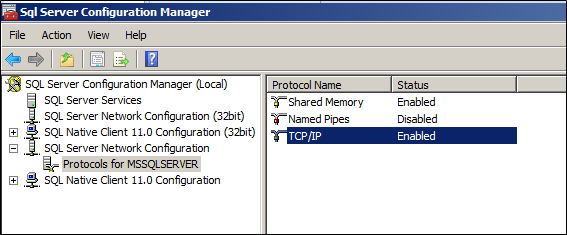
The MS SQL database is recommended to be used with the Latin type collation.
If you have Always On Availability Group (AOAG) configured for MS SQL, then follow the Microsoft recommendations for upgrading your AOAG configuration or refer to Set up Highly Available MS SQL Database on Windows. To upgrade SAS, see Upgrade.
SAS supports peer-to-peer replication. To configure replication, refer to
(https://docs.microsoft.com/en-us/sql/relational-databases/replication/transactional/peer-to-peer-transactional-replication?view=sql-server-ver15)
Disclaimer:
• Thales Group does not directly support MSSQL 2012.
• Customer DBA is responsible for the setup.
• Support can only help in a best effort approach.
To enhance SQL DB security, SAS supports Extended Protection and Force Encryption feature available in MS SQL Server Database.
Set up MS SQL with Windows Domain User
When configuring MS SQL with SAS server, using Windows Domain user, ensure that the connection is established with the trusted domain.
For example, if Domain A trusts Domain B and Domain B trusts Domain C, then users from Domain C can access resources in Domain A.
For detailed information about setting up a trust relationship, refer to the Microsoft Support website.
The Windows domain user used for making a connection with SAS should have the System Admin role in SQL server. This is applicable for all the Failover servers.
Configure Database Settings in SafeNet Authentication Service
-
Log in to SafeNet Authentication Service system as an administrator.
-
Click the SYSTEM tab. Then, under the Database module, click the SQL Database link.
-
In the Provider field, select MS SQL, and click Next.
-
Complete the following fields, and click Next:
Field Commment Host Enter the IP address of the MS SQL server. Database Enter the name of the MS SQL database that is to be created. User Name Enter the user name to be used by SAS to connect to the primary MS SQL database. For Windows domain user, provide the Windows user credentials. For example, domain\username. Password Enter the password associated with the user name. SSL Encryption Select the checkbox to enable the SSL communication with the SQL server. Windows Authentication Select the checkbox to enable the SQL Windows Authentication. 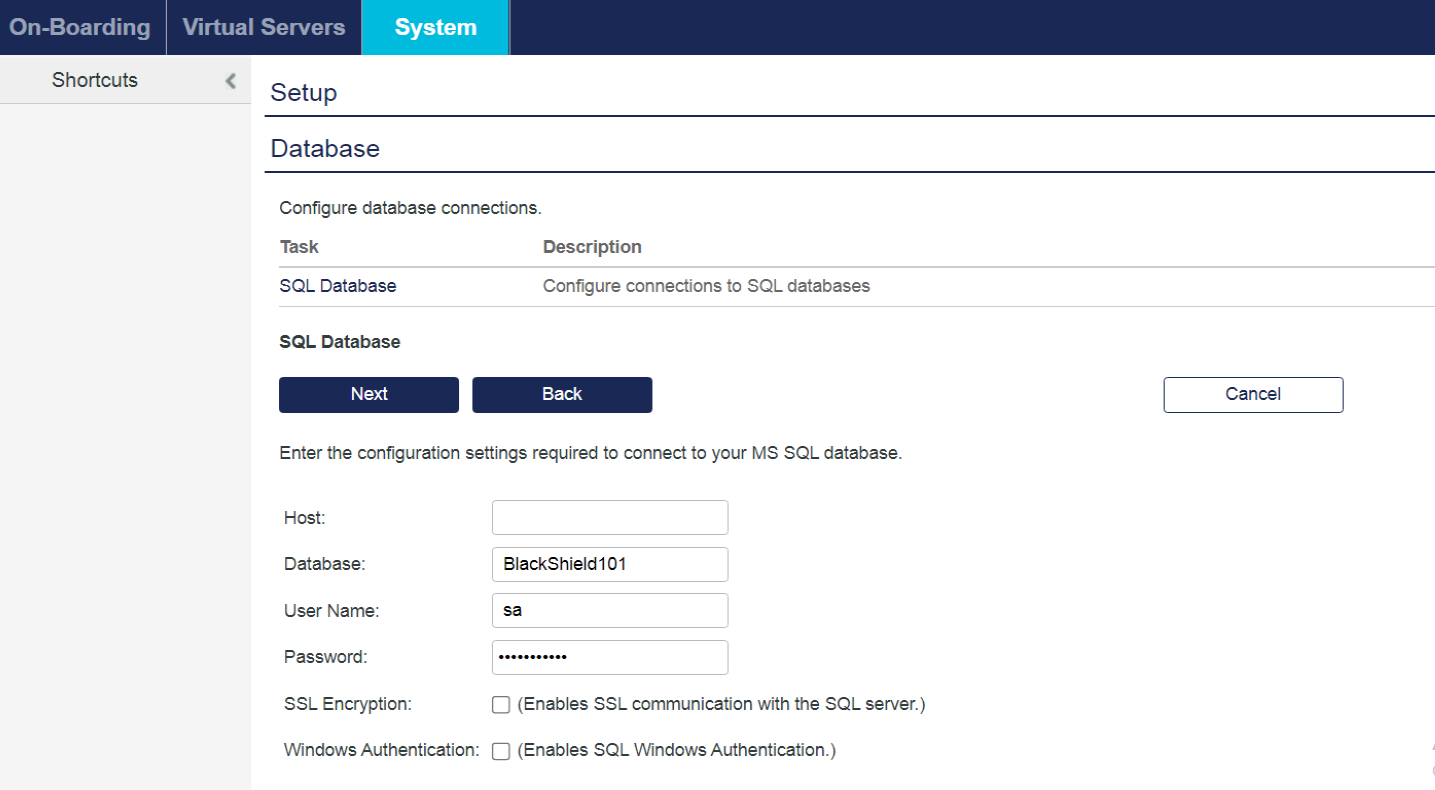
Set up MySQL database
You can configure MySQL database with or without High Availability (HA). The detailed information for setting up MySQL database with HA is given below.
Achieving high availability on the database level is essential for maintaining application availability. Databases are the center of today's enterprise and web applications. Just minutes of downtime can often result in significant amounts of revenue loss and unsatisfied customers. Making the database highly available is, therefore, a top priority for all organizations.
MySQL is used with many applications demanding availability and scalability. Availability refers to the ability to cope with and recover from failures on the host, including failures of MySQL, the operating system, or the hardware.
High Availability solution
The MySQL HA solution supported with SafeNet Authentication Service is MySQL Primary-Secondary Replication. MySQL Replication is the most popular and cost-effective HA solution.
Note
- Starting with SAS-PCE 3.22, it is recommended to delete existing SAS database users and replication users and recreate them using the caching_sha2_password authentication plugin in MySQL Workbench.
- Starting with MySQL 8.0.3x, MySQL introduced full support for the caching_sha2_password plugin. This plugin is the default authentication method in MySQL versions 8.4 and later. Alternately, to use MySQL server 8.0.25, it is necessary to explicitly create the SAS database users and replication users using the mysql_native_password plugin to ensure High Availability (HA) functionality.
MySQL replication
Replication enables data from one MySQL database server (the primary) to be copied to one or more MySQL secondary servers. The supported replication mode is asynchronous; secondary servers do not need to be connected permanently to receive updates from the primary server. The process of replication is not immediate and there might be some delay due to network latency.
A server involved in a replication setup has one of following roles:
-
Primary: A primary MySQL server writes all transactions that change data to a binary log.
-
Secondary: A secondary MySQL server connects to a primary (on start), downloads the transactions from the primary's binary log, and applies them to the local server.
Note
With SAS-PCE 3.22, Master-Slave terminology is changed to Source-Replica due to changes by MySQL.
Binary logs are files that contain details of every transaction that the MySQL server has executed. Secondary servers contact their primary to retrieve newer bits of the binary log, and apply the changes to their local database.
Consider a primary-secondary setup where a primary is connected with one secondary from the local network and one secondary via a VPN over the Internet.
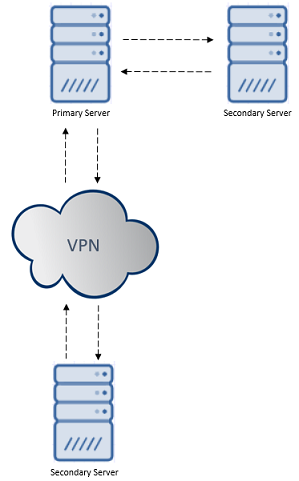
A setup such as this results in the two secondary servers having slightly different data. The locally attached secondary may be more up to date, because of added latency and bandwidth restrictions over the VPN connection.
If your MySQL replication setup is not working, you can view some troubleshooting techniques, by clicking here.
In a MySQL HA setup with one or more SAS servers, sometimes due to a known MySQL issue, an error comes up which says "Could not execute Write_rows event on table" and the status of that machine is shown as online, not replicating on the SAS console.
Consider a configuration of one SAS server (SAS1) with MySQL in HA mode (1 source, 2 replicas). HA management in the SAS console displays the status for all machines as Online, replicating. Next, configure another SAS server (SAS2) and import SAS1 to SAS2. Now, HA management in the SAS console displays the status of the source as Online, not replicating with an error saying "Could not execute Write_rows event on table".
The replica syncs its data from the source's binlog and saves the position up to where it has read data from source. If the replica remains offline for some time, then it will resume from that saved position only (independent of if source is changed during this duration). So there is no need to do Promote to Replica in this case it will automatically join back.
A replica comes back from its offline state automatically when the database schema of the source has not changed while the replica was offline.
If the database schema has changed and the replica does not start replicating automatically, perform the following steps:
-
Export data from the Primary machine.
-
Remove existing schema from the Secondary machines.
-
Import SQL file (exported from the Primary) in the Secondary machines.
-
Configure the database.
-
Go to HA Management section in the SAS Console and manually promote to source for it to show as Online, replicating.
In the case where we manually take a server out of the replication ring, the SAS administrator is required to go the SAS Console and manually promote to source for it to show as Online, replicating.
MySQL has also provided some recommendations to keep in mind while configuring to ensure that replication does not break in such cases.
Source-Source replication
Source-Source MySQL replication (also known as Active-Active replication) is a replication setup where two MySQL servers replicate to each other. It means:
-
Each server acts as both a source and a replica.
-
Changes made on Server A are replicated to Server B.
-
Changes made on Server B are replicated to Server A.
Ensure that the Source-Source replication is configured at the MySQL server(s). For more details, refer to the MySQL documentation.
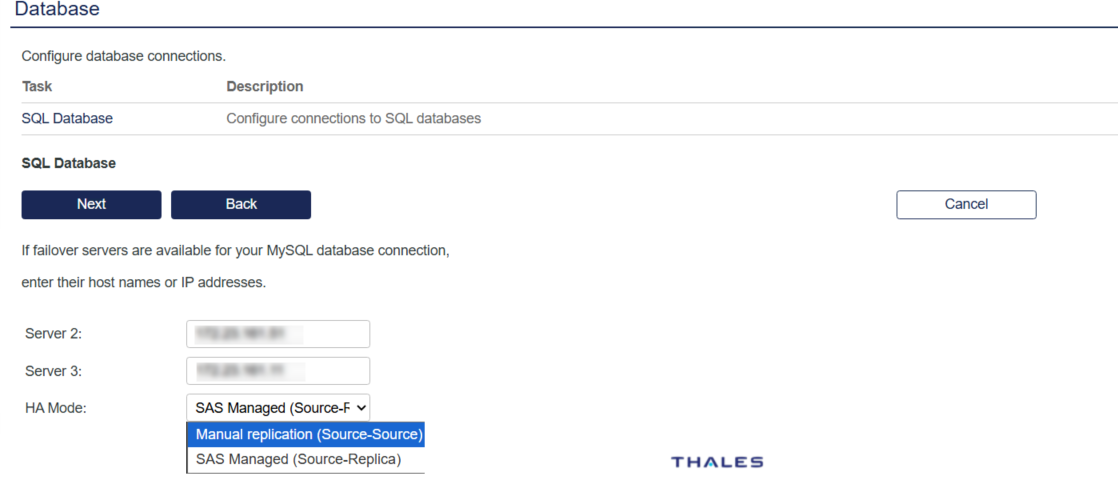
SAS High Availability Controller Service
SAS HA Controller Service is responsible for setting up and managing MySQL replication. It configures MySQL servers in primary-secondary mode. It also makes sure database is highly available to SAS.
If the primary MySQL server is not accessible to SAS, after trying 5 times to connect to the primary MySQL server the SAS HA Controller Service promotes an appropriate secondary MySQL server as a new primary.
Note
-
Authentication plugin support in SAS PCE with MySQL Server versions 8.0.33, 8.0.39, 8.4.5, and 9.2.0 is natively supported using the caching_sha2_password plugin by default.
-
For users intending to use MySQL Server 8.0.25, it is necessary to explicitly specify caching_sha2_password in the script when creating MySQL users.
Deployment scenario
Small-sized deployments
Scenario 1:
Server 1 (Primary MySQL DB)
Server 2 (SAS, HA Service, and Secondary MySQL DB)
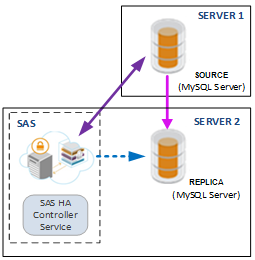
Scenario 2:
Server 1 (SAS and Primary MySQL DB)
Server 2 (SAS, HA Service, and Secondary MySQL DB)
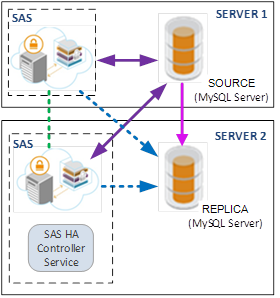
Medium-sized deployments
Scenario 1:
Server 1 (SAS and Primary MySQL DB)
Server 2 (Secondary MySQL DB)
Server 3 (SAS, HA Service, and Secondary MySQL DB)
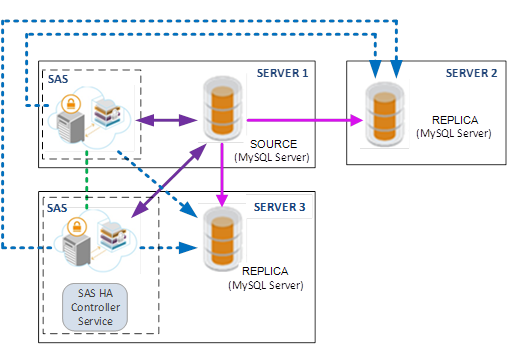
Scenario 2:
Server 1 (SAS and Primary MySQL DB)
Server 2 (SAS, HA Service, and Secondary MySQL DB)
Server 3 (SAS and Secondary MySQL DB)
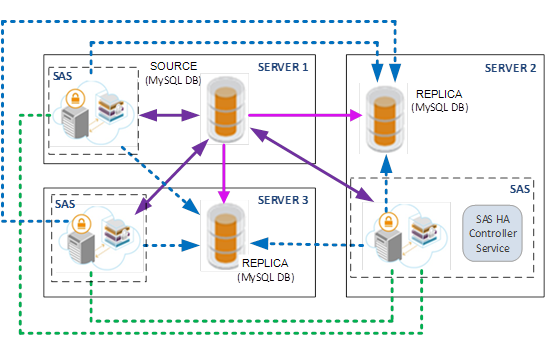
Only one SAS HA Controller Service (High Availability service) should be up and running for an SAS MySQL HA installation. Also, on the server where SAS HA Controller Service is active, you need to set the firewall rule in a way such that other SAS instances can access it.
In both the small-sized and medium-sized deployment scenarios illustrated below, notice the following:
-
All SAS instances on different servers interact only with the primary database to perform authentication.
-
All the changes done to the primary database are replicated to all the secondary databases.
-
All SAS instances on different servers are aware of all the secondary databases. When any of the secondary databases is promoted as a primary database, all SAS instances now interact with the new primary database to perform authentication.
-
All SAS instances without the HA Controller Service are connected to the SAS instance with the HA Controller Service. This is required for many purposes. For example, if there is a new primary database, all SAS instances now must be informed about it so that they can perform authentication. The intimation about the new primary database is done by the HA Controller Service.
In both small-sized and medium-sized deployment scenarios, ensure that the SAS HA Controller Service is not hosted on the same server as primary DB. This is due to the fact that when the server hosting primary DB goes down, the HA server should be up and running on the other machine so that it can act in time and initiate to promote a secondary as the new primary. In case of two secondary databases, the secondary with the most recent updates will be promoted as the new primary.
Set up Highly Available MS SQL Database on Windows
Prerequisite:
Enable TCP/IP Configuration in SQL Server Network Configuration.

Steps:
-
Verify if Always On High Availability is available on all the nodes. If not, see failover cluster configuration.
-
Ensure the MS SQL Server Enterprise Edition is installed.

-
Select Enable Always On Availability Groups, if not already selected.

-
Ensure the Full Recovery Model is set for the selected database.

-
Take Full backup of the database.

-
Select New Availability Group Wizard.

-
The New Availability Group wizard starts.

-
Provide an availability group name. This is the hostname to connect later on.

-
Select the database(s). Perform actions as indicated in the Status column.

-
Add all replicas (in case of any issues, turn off the firewall).


-
Check all Endpoints, note that firewalls should not block the used ports.

-
Configure backup preferences.

-
Specify a listener. This is the IP address used for the database connection (Do not use the cluster failover IP).

-
Go to Select Initial Data Synchronization. If you are starting with an empty database on the new cluster nodes select Full database and log backup so that all nodes are brought in a sync.

-
Check that validation passes.

-
Review the summary.

-
Check the progress.

-
Check that replicas are now available.

-
Connect to the AG Listener configured in step 6 & 11.

Troubleshoot for AOAG (failover cluster)
In case, one of the nodes are not synchronizing in MS SQL, even when SQL Server is up and running, and shows critical errors or warnings (as shown below):

This error occurs when the node is unstable while making connections. So the failover cluster does not allow the node to be available to availability groups/cluster so as to protect the cluster's availability. This could also cause the node to go under quarantine in Failover Cluster Manager.
To allow the node back into the cluster and to the synchronizing state, follow the below steps:
-
Go to the Failover Cluster Manager.

-
Select Roles.

-
Select Properties, then Failover tab.

-
Select the appropriate maximum failures in the particular time period (hours) and click OK. Refresh the Dashboard and verify it is working.

Set up highly available MySQL database on Windows
If a setup is running a primary-secondary configuration and a new secondary needs to be entered later, the whole setup can be done again.
Prepare MySQL servers
It is assumed that one primary and two secondary MySQL database servers will be on separate machines, and the MySQL database server is installed on each of these machines.
On each of the MySQL server, perform the following steps:
-
From the Windows Services application, stop the MySQL service.
-
From
%ProgramData%\MySQL\MySQL Server <version>\, open the my.ini file and add the below lines:######### START ##########
binlog-format=ROW
log-slave-updates=true
enforce-gtid-consistency = ON
gtid-mode=on
#disable-gtid-unsafe-statements=true # Use enforce-gtid-consistency from 5.6.9+
#master-info-repository=TABLE
#relay-log-info-repository=TABLE
sync-master-info=1
#datadir=/home/billy/mysql/data1
server-id=100
log-bin=utilBINLog-bin.log
relay-log=RELAYLog.log
report-host=10.164.44.246
binlog-do-db= BlackShield
replicate-do-db= BlackShield
########## End ##########Specify the values for the following parameters:
server-id: It is already specified in the my.ini file. You need to specify your own server IDs. Each server in replication must have a unique server ID.
log-bin: Name of a file that will be used as a log file.
relay-log: Name of the file that will be used as a relay log file.
report-host: IP address of the machine where the my.ini file exists.
binlog-do-db: Name of the database for which bin log is to be created.
replicate-do-db: Name of the database that is to be replicated (here, replicate-do-db and binlog-do-db are same).
-
From
%ProgramData%\MySQL\MySQL Server <version>\Data, delete theauto.cnffile. This will result in generating a unique GTID for the MySQL server.
All MySQL servers in replication must have a unique GTID. -
From the Windows Services application, start the MySQL service.
-
Ensure that the SAS database user is created on all the MySQL servers. If not created yet, run the following SQL commands on all the MySQL servers.
CREATE USER 'SAS DB User'@'IP address of the SAS server' IDENTIFIED BY 'password';
GRANT ALL PRIVILEGES ON *.* TO 'SAS DB User'@'IP address of the SAS server'; -
Now you need to create a replication user on all the MySQL database servers. This replication user will be responsible for communication between primary and secondary MySQL database servers. Note that username must NOT be same as you provided for the SAS database user in the previous step.
Note
- On all the MySQL servers, a MySQL user (termed as replication user) is required. This user must have the replication privileges and access to the mysql.users table.
- Each secondary MySQL database requires a MySQL user to connect to the primary MySQL database. So if you have three MySQL databases (one primary and two secondary) on separate machines then each database requires MySQL users associated with the other two machines. The user name and password of must be same as the replication user.
On the primary MySQL database server, run the following SQL commands.
CREATE USER 'ReplicationUser'@'IP address of the machine where SAS HA Controller service is hosted' IDENTIFIED BY 'password';GRANT ALL PRIVILEGES ON *.* TO 'ReplicationUser'@'IP address of the machine where SAS HA Controller service is hosted' WITH GRANT OPTION;CREATE USER 'ReplicationUser'@'IP address of the first secondary MySQL server' IDENTIFIED BY 'password';GRANT ALL PRIVILEGES ON *.* TO 'ReplicationUser'@'IP address of the first secondary MySQL server';CREATE USER 'ReplicationUser'@'IP address of the second secondary MySQL server' IDENTIFIED BY 'password';GRANT ALL PRIVILEGES ON *.* TO 'ReplicationUser'@'IP address of the second secondary MySQL server'; -
On the first secondary MySQL database server, run the following SQL commands. Note that username and password must be same as you provided in the previous step.
CREATE USER 'ReplicationUser'@'IP address of the machine where SAS HA Controller service is hosted' IDENTIFIED BY 'password';GRANT ALL PRIVILEGES ON *.* TO 'ReplicationUser'@'IP address of the machine where SAS HA Controller service is hosted' WITH GRANT OPTION;CREATE USER 'ReplicationUser'@'IP address of the primary MySQL server ' IDENTIFIED BY 'password';GRANT ALL PRIVILEGES ON *.* TO 'ReplicationUser'@'IP address of the primary MySQL server';CREATE USER 'ReplicationUser'@'IP address of the second secondary MySQL server' IDENTIFIED BY 'password';GRANT ALL PRIVILEGES ON *.* TO 'ReplicationUser'@'IP address of the second secondary MySQL server'; -
On the second secondary MySQL database server, run the following SQL commands. Note that username and password must be same as you provided in the previous step.
CREATE USER 'ReplicationUser'@'IP address of the machine where SAS HA Controller service is hosted' IDENTIFIED BY 'password';GRANT ALL PRIVILEGES ON *.* TO 'ReplicationUser'@'IP address of the machine where SAS HA Controller service is hosted' WITH GRANT OPTION;CREATE USER 'ReplicationUser'@'IP address of the primary MySQL server' IDENTIFIED BY 'password';GRANT ALL PRIVILEGES ON *.* TO 'ReplicationUser'@'IP address of the primary MySQL server';CREATE USER 'ReplicationUser'@'IP address of the first secondary MySQL server ' IDENTIFIED BY 'password';GRANT ALL PRIVILEGES ON *.* TO 'ReplicationUser'@'IP address of the first secondary MySQL server';
Set up highly available MySQL database on Linux
Perform the following steps to set up MySQL HA with Linux environment:
-
Using the Terminal, stop the MySQL service by running the following command:
]# service mysqld stop -
Open the /etc/my.cnf file and add the below lines within [
mysqld]:######### START ##########
binlog-format=ROW
log-slave-updates=trueenforce-
gtid-consistency=truegtid-mode=on
#disable-gtid-unsafe-statements=true # Use enforce-gtid-consistency from 5.6.9+
master-info-repository=TABLE
relay-log-info-repository=TABLE
sync-master-info=1#
datadir=/home/billy/mysql/data1
server-id=100
log_bin=/var/lib/mysql/mysql-bin.log#
relay-log=RELAYLog.log
report-host=10.164.44.246
binlog_do_db= BlackShield
replicate_do_db= BlackShield
report-port=3306
########## End ##########Specify the values for the following parameters:
server-id: It is already specified in the my.ini file. You need to specify your own server IDs. Each server in replication must have a unique server ID.
log_bin: Name of a file that will be used as a log file.
relay-log: Name of the file that will be used as a relay log file.
report-host: IP address of the machine where the my.ini file exists.
binlog_do_db: Name of the database for which bin log is to be created.
replicate_do_db: Name of the database that is to be replicated (here, replicate_do_db and binlog_do_db are same).
-
Delete the auto.cnf file available at the following location:
/var/lib/mysql
This will result in generation of a unique GTID for the MySQL server. All MySQL servers that are in replication must have a unique GTID. -
Using the Terminal, start the MySQL service by running the following command:
]# service mysqld start -
Ensure that the SAS database user is created on all the MySQL servers. If not created yet, run the following SQL commands on all the MySQL servers.
CREATE USER 'SAS DB User'@'IP address of the SAS server' IDENTIFIED BY 'password';
GRANT ALL PRIVILEGES ON *.* TO 'SAS DB User'@'IP address of the SAS server'; -
Now you need to create a replication user on all the MySQL database servers. This replication user will be responsible for communication between primary and secondary MySQL database servers. Note that username must NOT be same as you provided for the SAS database user in the previous step.
Note
- On all the MySQL servers, a MySQL user (termed as replication user) is required. This user must have the replication privileges and access to the mysql.users table.
- Each secondary MySQL database requires a MySQL user to connect to the primary MySQL database. So if you have three MySQL databases (one primary and two secondary) on separate machines then each database requires MySQL users associated with the other two machines. The user name and password of must be same as the replication user.
On the primary MySQL database server, run the following SQL commands.
CREATE USER 'ReplicationUser'@'IP address of the machine where SAS HA Controller service is hosted' IDENTIFIED BY 'password';GRANT ALL PRIVILEGES ON *.* TO 'ReplicationUser'@'IP address of the machine where SAS HA Controller service is hosted' WITH GRANT OPTION;CREATE USER 'ReplicationUser'@'IP address of the first secondary MySQL server' IDENTIFIED BY 'password';GRANT ALL PRIVILEGES ON *.* TO 'ReplicationUser'@'IP address of the first secondary MySQL server';CREATE USER 'ReplicationUser'@'IP address of the second secondary MySQL server' IDENTIFIED BY 'password';GRANT ALL PRIVILEGES ON *.* TO 'ReplicationUser'@'IP address of the second secondary MySQL server'; -
On the first secondary MySQL database server, run the following SQL commands. Note that username and password must be same as you provided in the previous step.
CREATE USER 'ReplicationUser'@'IP address of the machine where SAS HA Controller service is hosted' IDENTIFIED BY 'password';GRANT ALL PRIVILEGES ON *.* TO 'ReplicationUser'@'IP address of the machine where SAS HA Controller service is hosted' WITH GRANT OPTION;CREATE USER 'ReplicationUser'@'IP address of the primary MySQL server ' IDENTIFIED BY 'password';GRANT ALL PRIVILEGES ON *.* TO 'ReplicationUser'@'IP address of the primary MySQL server';CREATE USER 'ReplicationUser'@'IP address of the second secondary MySQL server' IDENTIFIED BY 'password';GRANT ALL PRIVILEGES ON *.* TO 'ReplicationUser'@'IP address of the second secondary MySQL server'; -
On the second secondary MySQL database server, run the following SQL commands. Note that username and password must be same as you provided in the previous step.
CREATE USER 'ReplicationUser'@'IP address of the machine where SAS HA Controller service is hosted' IDENTIFIED BY 'password';GRANT ALL PRIVILEGES ON *.* TO 'ReplicationUser'@'IP address of the machine where SAS HA Controller service is hosted' WITH GRANT OPTION;CREATE USER 'ReplicationUser'@'IP address of the primary MySQL server' IDENTIFIED BY 'password';GRANT ALL PRIVILEGES ON *.* TO 'ReplicationUser'@'IP address of the primary MySQL server';CREATE USER 'ReplicationUser'@'IP address of the first secondary MySQL server ' IDENTIFIED BY 'password';GRANT ALL PRIVILEGES ON *.* TO 'ReplicationUser'@'IP address of the first secondary MySQL server';The procedure help is provided to support SAS setup with MySQL HA on Linux (machines) and should primarily be managed by customer's database administrators. Since Linux is not an officially supported operating system with SAS, best effort support can be provided from the application end, in case of any issues.
Configure database settings in SafeNet Authentication Service
Ensure that in the registry, the HKEY_LOCAL_MACHINE\SOFTWARE\CRYPTOCard\BlackShield ID\DAL\HAService\HAModeEnable key is set to FALSE.
-
Log in to SafeNet Authentication Service system level as an administrator.
-
Click the SYSTEM tab. Then, under the Database module, click the SQL Database link.

-
In the Provider field, select MySQL, and click Next.
Note
- For PostgreSQL database, ensure that the default port is set to 5432.
- To connect MySQL database, you will require MySQL Connector. If it is already not installed on your system, the following screen (with a download link and installation steps) is displayed. During installation, ensure that you choose either Typical or Complete installation.
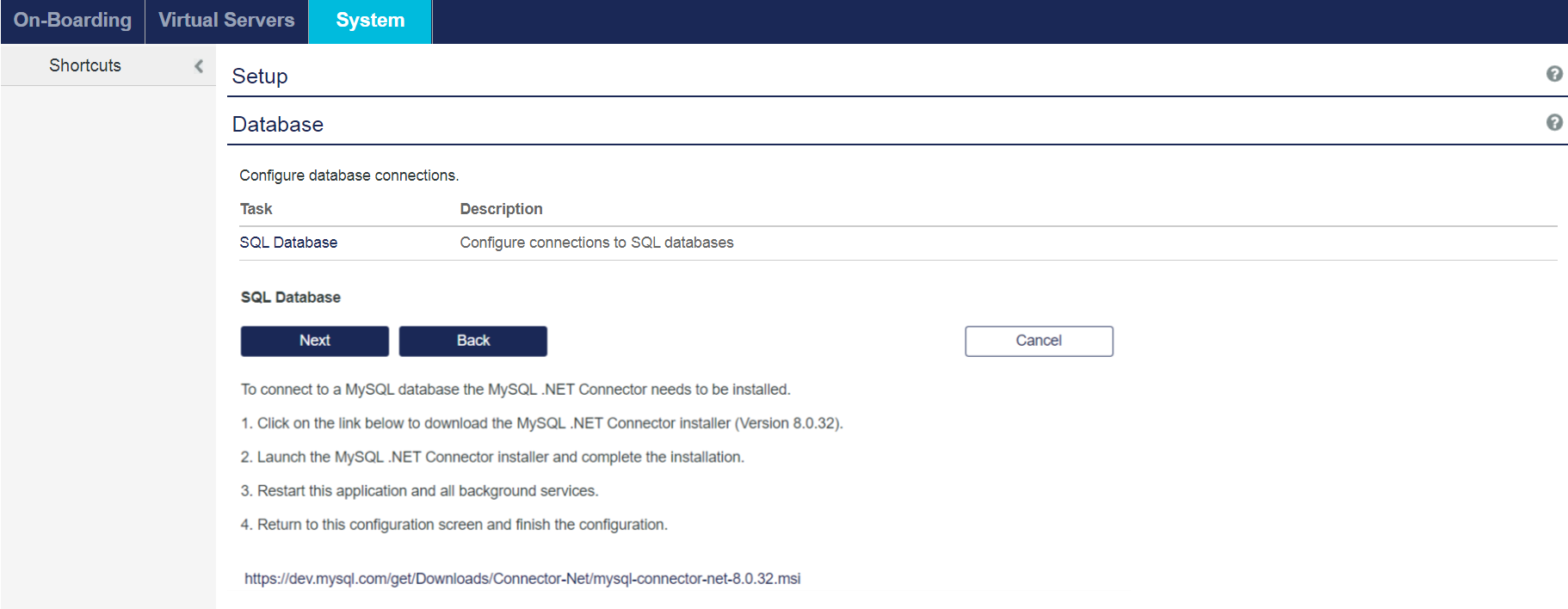
If any version of the MySQL Connector is already installed, you have to manually remove it before installing MySQL Connector 9.2.0. On installing the MySQL Connector, the Administrator will be logged out of the application, and will have to login again to complete the rest of the configurations.
-
Complete the following fields, and click Next.
Field Comment Server 2 Enter the IP address of the first secondary MySQL server. Server 3 Enter the IP address of the second secondary MySQL server. HA Mode Select SAS Managed (Source-Replica) option. The SafeNet Authentication Service will use the same credentials given in the previous step to connect to the secondary MySQL servers.

-
Complete the following fields, and click Next:
Field Comment HA Service IP Enter the IP address of the machine where SAS HA Controller Service is installed. HA Service Port Enter the port number on which SAS HA Controller Service is listening. User Enter the name of the user that will be used by SAS HA Controller Service for replication setup. Password Enter the password associated with the user. 
Generally, the machine where SAS HA Controller Service is installed is the primary SAS server. While adding additional SAS sites, when you export and import the primary SAS server, the information regarding the MySQL HA Service URL is also copied.
-
A success message is displayed. Click Next.
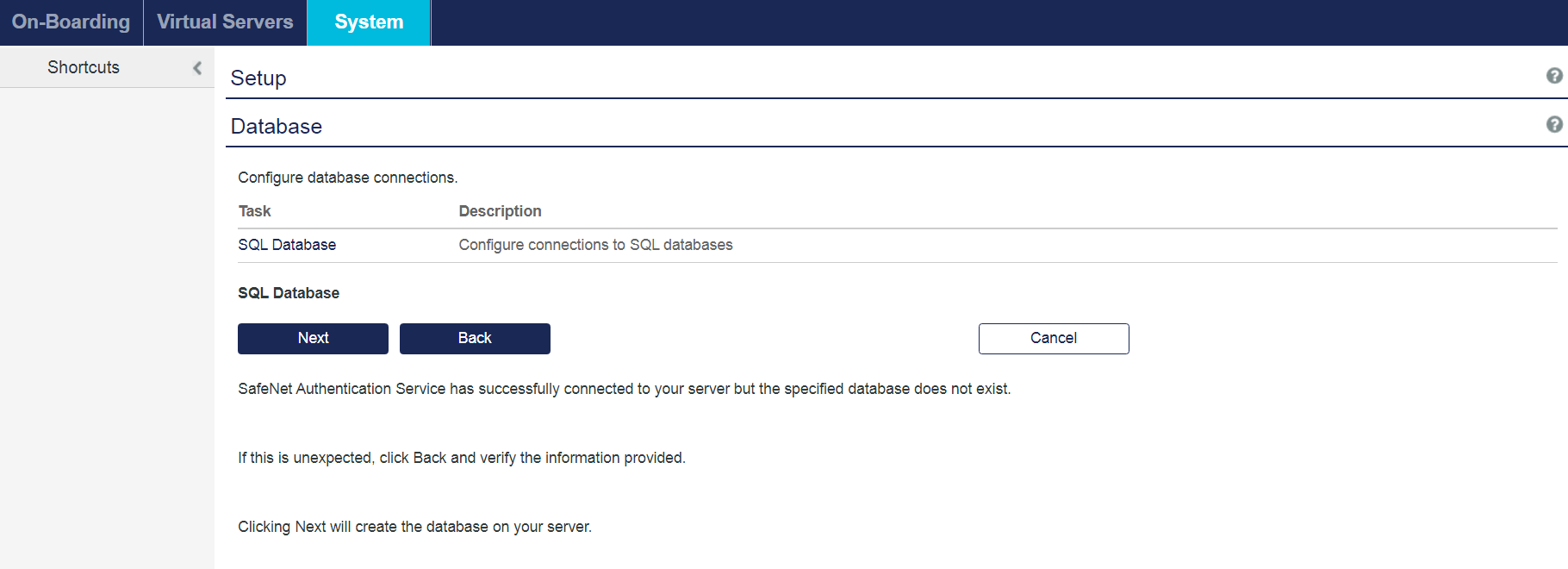
-
Database configuration is complete. Click Done.

Automatic switching primaries during failover
When the primary MySQL database becomes unavailable, one of the secondary MySQL databases (the one that is most updated) is automatically promoted to primary. You need to manually troubleshoot the previous primary database. Once it is online, you can add it as a secondary (see Promoting MySQL Server to Secondary).
If the MySQL server is in the Online, Non-Replicating status and you want to add it to the replication topology, you need to promote it to secondary.
-
Click the SYSTEM tab. In the Database module, click the HA Management link. The details of the primary and secondary databases are displayed.

-
This secondary MySQL server will now be shown as online but not replicating. Click the Promote to Replica link for this server.
Note
After performing any High Availability (HA) management action—such as promoting to source or replica—allow sufficient time for replication to complete before proceeding with further steps.
Administration activities
The administration activities that you can perform are detailed in the sections below.
Promote secondary MySQL server to primary
Due to any reason (for example, to use upgraded hardware for high performance), you may require promoting any of the secondary MySQL servers to primary.
Log in to SafeNet Authentication Service system level as an administrator.
-
Click the SYSTEM tab. In the Database module, click the HA Management link.
The details of the primary and secondary databases are displayed. -
To promote any of the secondary MySQL Servers to a primary, click the respective Promote to Source link.
If a secondary MySQL server that you are trying to promote to primary is not up to date, a message is displayed and promoting to primary activity is discarded.
Promote MySQL server to secondary
If the MySQL server is in the Online, Non-Replicating status and you want to add it to the replication topology, you need to promote it to secondary.
-
Click the SYSTEM tab. In the Database module, click the HA Management link. The details of the primary and secondary databases are displayed.
-
This secondary MySQL server will now be shown as online but not replicating. Click the Promote to Replica link for this server.
Note
In case of any replication issue on any replica server, you can follow the steps mentioned in the MySQL database replication section to restore replication on the affected replica machine.
Add secondary MySQL server
If you want to add a secondary MySQL server, you need to do the following:
-
In the registry, set HAModeEnable to False.
-
Turn off all services of SAS.
-
On the primary MySQL database, run this command. Then, copy the value and keep it for later use.
show global variables like 'gtid_executed'; -
In the MySQL workbench, set the following parameter to OFF.
set-gtid-purged – Add ‘SET @@GLOBAL.GTID_PURGED’ to the output -
Export the primary MySQL database.
-
On the existing secondary MySQL server, delete the MySQL database. Then, run stop replica command on this MySQL server.
-
Ensure that the my.ini file settings on both the secondary servers are correct, and DB and replication users are properly created. For more information, refer to Preparing MySQL Servers.
-
Create a database with the same name as a primary database on both the MySQL servers to be added as a secondary server.
-
On both the secondary MySQL servers, import the primary MySQL database you exported earlier.
-
Run the RESET SOURCE command on both the secondary servers.
-
Run the following command on both the secondary servers after replacing gtid_executed_value with the value you copied in step 3:
set global GTID_PURGED=’gtid_executed_value’; -
Configure database settings in SafeNet Authentication Service. For more details, refer to Configuring Database Settings in SafeNet Authentication Service.
-
Turn on all services of SAS.
Remove secondary MySQL server
If you want to remove a secondary MySQL server, you need to do the following:
-
In the registry, set HAModeEnable to False.
-
Turn off all services of SAS.
-
Configure database settings in SafeNet Authentication Service. For more details, refer to Configuring Database Settings in SafeNet Authentication Service
-
Turn on all services of SAS.
Set up FreeRADIUS API
In case of a fresh SAS installation with MySQL database, RADIUS API may encounter an issue with MySQL database (MySQL EF6 DLL in GAC missing). The issue is encountered if the MySQL Connector version is 9.2.0.
Ensure that the following steps are already performed:
After installing SAS, install MySQL 9.2.0 Connector. Configure SAS with MySQL database using the following steps.
This setting is also required to setup Agent Communication for specific SafeNet agents, such as the SAS Agent for FreeRADIUS.
For Windows Server 2012, 2012 R2, 2016, and 2022
- Click here to download the mysql.data.entityframework.9.2.0 nuget package. This library is freely available from Oracle’s MySQL website and must be used in compliance with the GPL-2.0 license. Ensure to understand the GPL-2.0 obligations before using this library.
- Change the extension of the downloaded package from .nupkg to .zip by renaming the package.
- Extract the package mysql.data.entityframework.9.2.0.zip.
- Open the extracted folder, navigate to lib > net462 > MySql.Data.EntityFramework.dll, and copy the complete path of this DLL file. It will be required in the next step.
-
Copy the following text in a text file and save the file in the .ps1 file format. Also check and update the DLL path as per the above step:
# Note that you should be running PowerShell as an Administrator
[System.Reflection.Assembly]::Load("System.EnterpriseServices, Version=4.0.0.0, Culture=neutral, PublicKeyToken=b03f5f7f11d50a3a")
$publish = New-Object System.EnterpriseServices.Internal.Publish
$publish.GacInstall("C:\Downloads\mysql.data.entityframework.9.2.0\lib\net462\MySql.Data.EntityFramework.dll")
# If installing into the GAC on a server hosting web applications in IIS, restart IIS for changes to take effect
iisreset -
Run the .ps1 file as an administrator in the PowerShell.
-
To validate whether your script runs successfully, go to C:\Windows\Microsoft.NET\assembly\GAC_MSI and verify that MySql.Data.EntityFramework folder is created after execution of the above script.

Points to remember
-
Default location:
System Directory:\Downloads\mysql.data.entityframework.9.2.0\lib\net462(Assuming it will be the path of your directory where the nuget package is downloaded)
-
Open the PowerShell script and change the path to where your DLL resides.
Setting up MS SQL database
You can configure MS SQL database with or without high availability. MS SQL is used with many applications demanding availability and scalability. If you need to work with AlwaysOn Availability Groups in MS SQL, follow the steps to configure and set it up with the SAS solution.
While configuring SAS using AOAG in MS SQL, ensure to enter the listener name in the Host field.
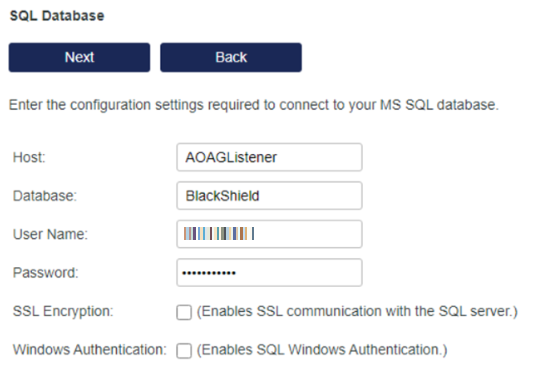
The procedure’s help reference is provided to support SAS setup with the respective HA model and should primarily be managed by customer's database administrators. Best effort support can be provided from the application end in case of any issues.
Troubleshooting
For Hardware Failures of Machine Hosting MySQL Server / Secondary out of Replication
-
Turn off all services of SAS.
-
On the primary MySQL database, run this command. Then, copy the value and keep it for later use.
show global variables like 'gtid_executed'; -
In the MySQL workbench, set the following parameter to OFF.
set-gtid-purged – Add ‘SET @@GLOBAL.GTID_PURGED’ to the output -
Export the primary MySQL database.
-
Rectify the hardware problem of the machine or get a new machine. Make sure the machine IP address is same as earlier.
-
Ensure that the my.ini file settings on the secondary machine are correct, and DB and replication users are properly created. For more information, refer Preparing MySQL Servers.
-
During report generation, if the following error message is displayed:
*SQL ExecuteNonQuery Failed to Execute due to following error: Packets larger than max_allowed_packet are not allowed.-2147467259*
Make the following edit: For MS SQL
Go to Database -> Properties -> Advanced -> Max Text Replication Size = -1.
For My SQL
Go toC:\ProgramData\MySQL\MySQL Server <version>\my.ini
Set max_allowed_packet in my.ini file to 1073741824. -
Start secondary servers with the skip_replica_start option.
-
Create a database with the same name as the primary database.
-
Import the primary MySQL database you exported earlier.
-
Run the RESET SOURCE command on the secondary server.
-
Run the following command on the secondary server after replacing gtid_executed_value with the value you copied earlier:
set global GTID_PURGED=’gtid_executed_value’; -
Turn on all services of SAS.
-
Using the HA Management User Interface (UI) in SafeNet Authentication Service, promote this machine as a secondary. For more details, refer Promoting MySQL Server to Secondary.
-
If the MySQL server is in the Online, Non-Replicating status and you want to add it to the replication topology, you need to promote it to secondary.
-
Click the SYSTEM tab. In the Database module, click the HA Management link. The details of the primary and secondary databases are displayed.
-
This secondary MySQL server will now be shown as online but not replicating. Click the Promote to Replica link for this server.
-
If you have 1 primary and 2 secondary MySQL servers. Both the secondary MySQL servers are out of replication: Add both the secondary MySQL servers in the replication topology.
Refer Adding Secondary MySQL Server. -
If you have 1 primary and 2 secondary MySQL servers. Now, one secondary server is replicating and the other secondary server is out of replication.
-
-
On the replicating secondary MySQL server, perform the following steps:
-
Run the stop replica command.
-
Run the following command, and then copy the value and keep it for later use:
show global variables like 'gtid_executed'. -
In the MySQL workbench, set the following parameter to OFF.
set-gtid-purged – Add ‘SET @@GLOBAL.GTID_PURGED’ to the output. -
Export MySQL database.
-
Run the start replica command.
-
-
On the non-replicating secondary MySQL server, perform the following steps:
-
Run the stop replica command.
-
Delete the existing database.
-
Create a database with the same name as the previous database.
-
Import the MySQL database you exported.
-
Run the RESET SOURCE command on MySQL server. Run the following command on this MySQL server after replacing gtid_executed_value with the value you copied:
set global GTID_PURGED=’gtid_executed_value’;
-
-
Using the HA Management UI in SafeNet Authentication Service, promote this machine as a secondary. For more details, refer Promoting MySQL Server to Secondary.
-
If the MySQL server is in the Online, Non-Replicating status and you want to add it to the replication topology, you need to promote it to secondary.
- Click the SYSTEM tab. In the Database module, click the HA Management link. The details of the primary and secondary databases display.
Note
With SAS-PCE 3.22, Master-Slave terminology is changed to Source-Replica due to changes by MySQL.

This secondary MySQL server will now be shown as online but not replicating. Click the Promote to Replica link for this server.
-
When all the machines (SAS, SAS HA Controller Service, and all MySQL servers in the replicating topology) are powered off:
-
Power on the primary MySQL machine and make sure that the MySQL service is started.
-
Power on rest of the MySQL machines (secondary machines) and start the MySQL service on these machines.
-
Start the SAS HA Controller Service, if it is installed on the machine other than the SAS server.
-
Start the SAS server.
-
-
In the HA Management user interface, if the secondary servers are shown as online but not replicating, click the Promote to Replica link for these servers.
Restore SAS server
This section describes the steps required to migrate and restore a SAS server from one environment to the other. This includes migrating a SAS server from one operating system environment (e.g., Windows Server 2012) to a different environment (e.g., Windows Server 2016).
SAS server backup
-
Cipher Key export
-
SAS database backup
-
SAS license backup
-
SAS installer(s) backup
Exporting Cipher Key
Perform the following steps to export the Cipher key:
-
Open the command prompt and run the command to open the SAS CipherExport tool (CipherExport.exe) that is located in the SAS Server installation directory, <InstallationDrive>:\Program Files\CRYPTOCard\Blackshield ID\CipherExport
-
Run the following export command:
CipherExport.exe export cipher-export.txt
The command creates the cipher-export.txt file (in the same directory, where the CipherExport.exe tool is located) and an Export File Key.
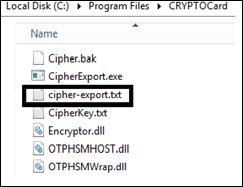
-
Copy the Export File Key and paste it in a .txt file and save the file (for example, ExportFileKey.txt).
-
Place the text files (cipher-export.txt and ExportFileKey.txt) at a secured location as these files are required while restoring the SAS Server.
You need to run the SAS CipherExport tool on all the SAS servers.
SAS Database Backup
For database backup, you need to stop the following services before initiating the database process.
-
IIS Admin
-
World Wide Web
-
all SAS Services
For backup steps related to PostGreSQL, MySQL, and MSSQL databases, refer to the documentation provided by the respective database vendor.
SAS License Backup
Save the SAS license file and the Activation key at a secured location.
SAS Installer(s) Backup
Take a backup of the SAS installation files.
SAS Server Restore
-
SAS installation
-
Cipher Key import
SAS Installation
As per the requirement, install the same version SAS again to ensure that it can connect to the database(s) without any issue.
Importing Cipher Key
Perform the following steps to import the Cipher key:
-
Open the command prompt and run the command to open the SAS CipherExport tool (CipherExport.exe) that is located in the SAS Server installation directory, <InstallationDrive>:\Program Files\CRYPTOCard\Blackshield ID\CipherExport
-
Copy the cipher-export.txt file.
-
On the system where you want to restore SAS, paste the cipher-export.txt file at the same location where the CipherExport.exe tool is located.
-
Run the following import command:
CipherExport.exe import ‘cipher-export.txt’ ‘Export File Key value’where, cipher-export.txt file and Export File Key value were created while exporting the Cipher key.
After the successful execution of the import command, the Cipher Imported message is displayed that states that Cipher key is successfully imported.

-
Restore the database. For the restore steps related to PostGreSQL, MySQL, and MSSQL database, refer to the documentation provided by the respective database vendor.
-
On the local SAS Server, log in to the SAS Manager Console.
-
SAS will redirect you to the SQL Database configuration wizard. Run the wizard to connect to the correct database provider and configure the restored database.
-
After running the SQL Database configuration wizard, logout from the SAS console and reset the IIS by using IISRESET command.
-
Log in to the SAS Console again.
Verify the following settings and modify them accordingly:
-
Email Setting: System > Communications > Email Settings
-
Self Service Policy: Virtual Server > Self-Service > Self-Service Policy
-
Self Enrollment Policy: Virtual Server > Policy > Automation Policies > Self-Enrollment Policy
-
Operator Email Validation URL: System > Communications > Operator Email Validation URL

